DOI: https://doi.org/10.1038/s41467-024-45108-2
PMID: https://pubmed.ncbi.nlm.nih.gov/38286989
تاريخ النشر: 2024-01-29
التقطير الشمسي المستدام المستوحى من الطبيعة مع تبلور الحواف لجمع الملح بشكل سلبي وعدم تصريف المياه المالحة
تاريخ القبول: 15 يناير 2024
تاريخ النشر على الإنترنت: 29 يناير 2024
(أ) تحقق من التحديثات
الملخص
تتطلب الحاجة الملحة لمعالجة ندرة المياه والزيادة السكانية السريعة استخدام تحلية مستدامة لإنتاج مياه نظيفة، بينما تستهلك عمليات التحلية الحرارية التقليدية الوقود الأحفوري مع رفض المحلول الملحي. كحل واعد للتقطير الشمسي الحراري المستدام، نبلغ عن جهاز مستوحى من أشجار المانغروف قابل للتوسع لإنتاج بخار الشمس المباشر وجمع الملح بشكل سلبي دون تصريف المحلول الملحي. يتم ضمان إمداد المياه المالحة المدفوعة بالتوتر السطحي وتوليد البخار المستمر بواسطة ساق مسامي مضاد للتآكل وأوراق متعددة الطبقات، مصنوعة من شبكات التيتانيوم النانوية فائقة المحبة للماء ومنخفضة التكلفة. الملح المتساقط عند حافة الورقة يشكل بقعة مسامية خلال تبخر النهار ويتم إزالته بواسطة الجاذبية خلال الليل عندما تعيد المياه المالحة ترطيب الأوراق، ويمكن أن تعزز هذه البقع الملحية التبخر بمعدل 1.6 مرة كما تشير نتائجنا. يحقق مولد بخار الشمس المقترح كفاءة حرارية ضوئية مستقرة تبلغ حوالي 94% تحت شمس واحدة عند معالجة مياه البحر الاصطناعية بملوحة
بصمة كربونية كبيرة
تجعله ممتصًا شمسيًا ممتازًا مع خصائص فائقة المحبة للماء ومضادة للتآكل. تم تقييم أداء التبخر وتبلور الملح للأوراق الاصطناعية
النتائج
التصميم المفاهيمي لـ SVGC
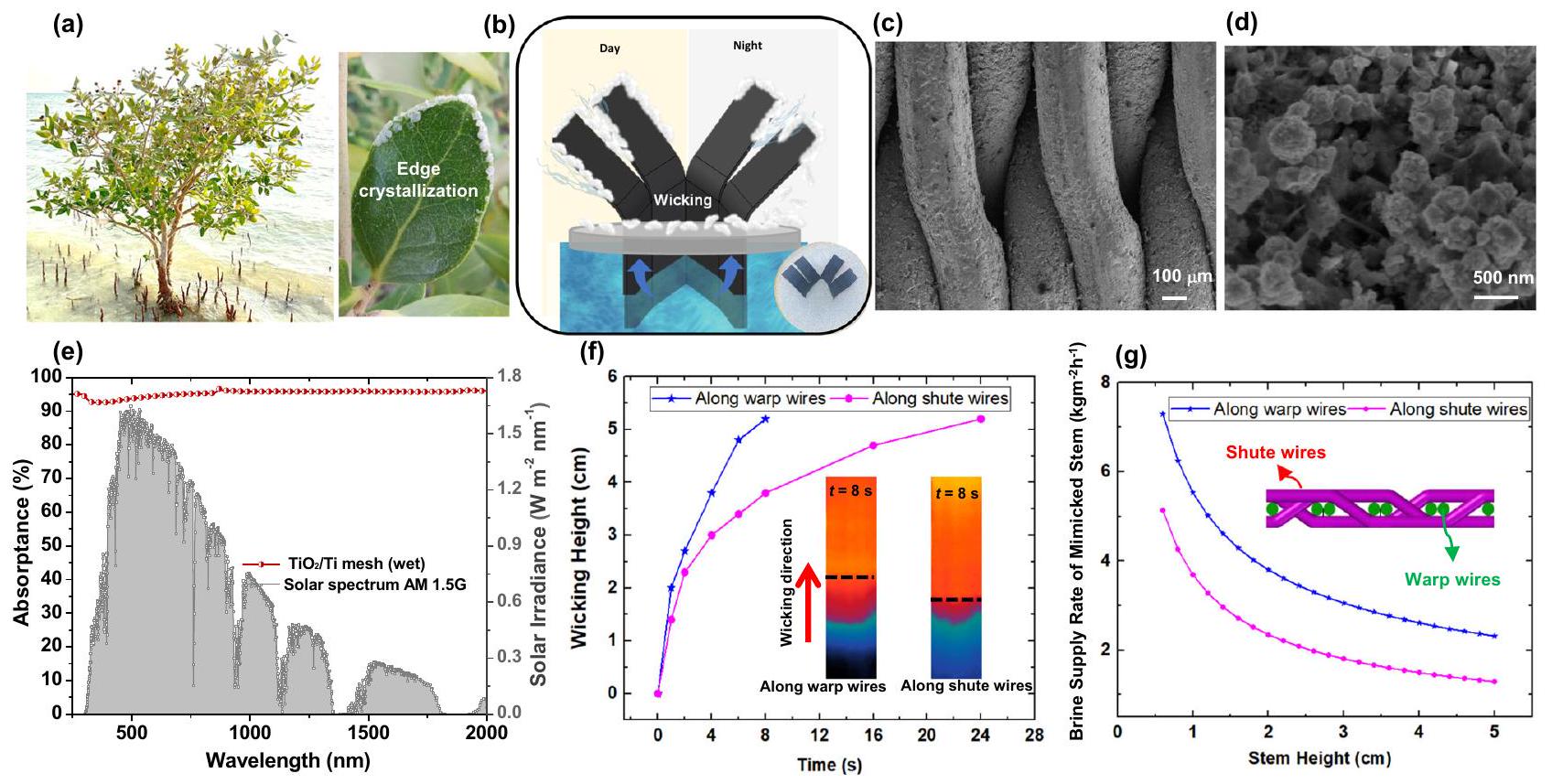
الذي يتكون من التيتانيوم ذو الهيكل النانوي/الميكروي (
وظيفة ارتفاع الساق (الشكل 1g). لقد أظهرت نتائجنا أن معدل إمداد المياه أقل في الأسلاك المائلة مقارنة بالأسلاك العمودية. وتبين أن قدرة الضخ تتأثر بشكل كبير بارتفاع الساق، وتتناقص مع زيادة ارتفاع الساق.
تحسين التصميم وتحليل الأداء لـ SVGC
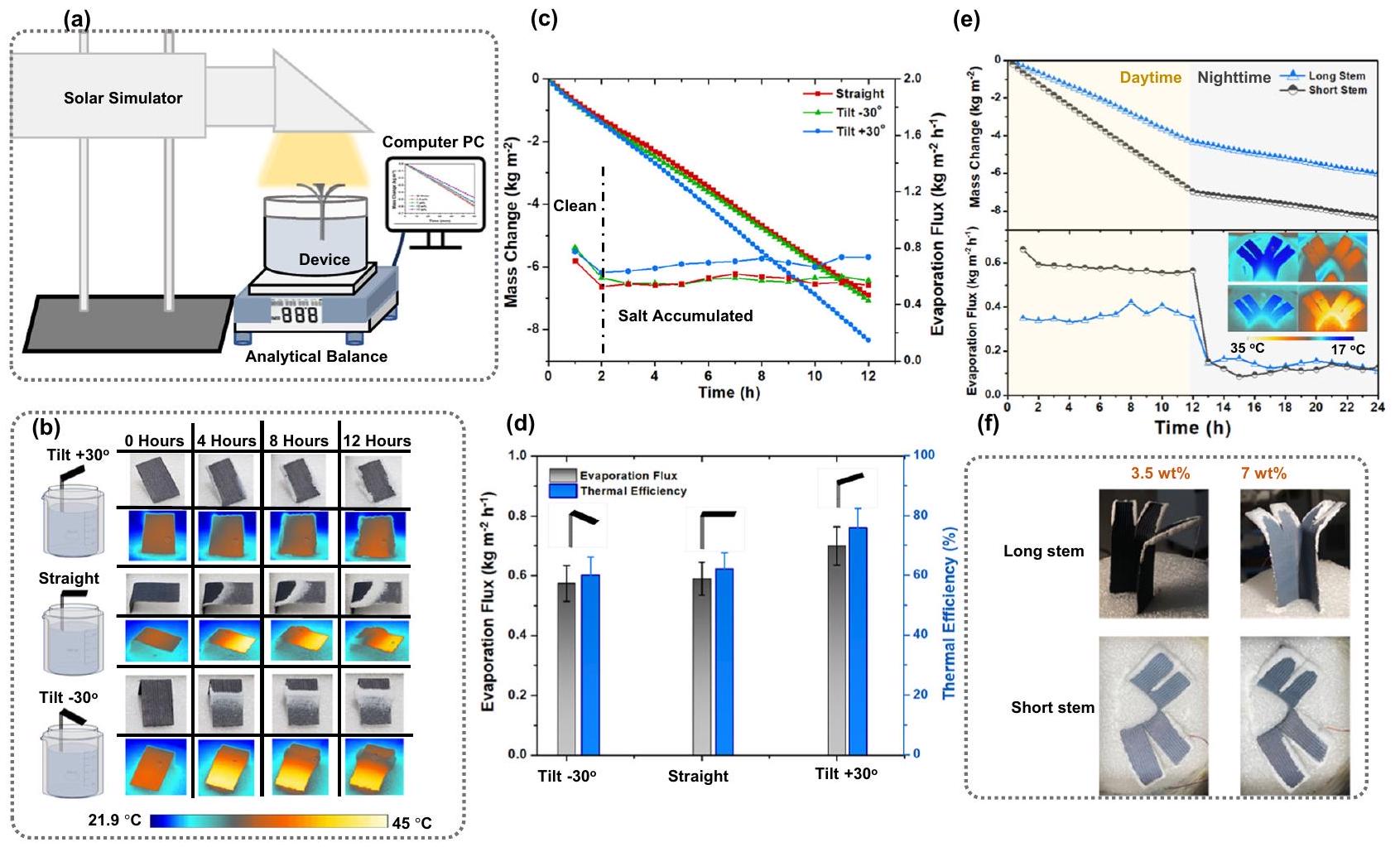
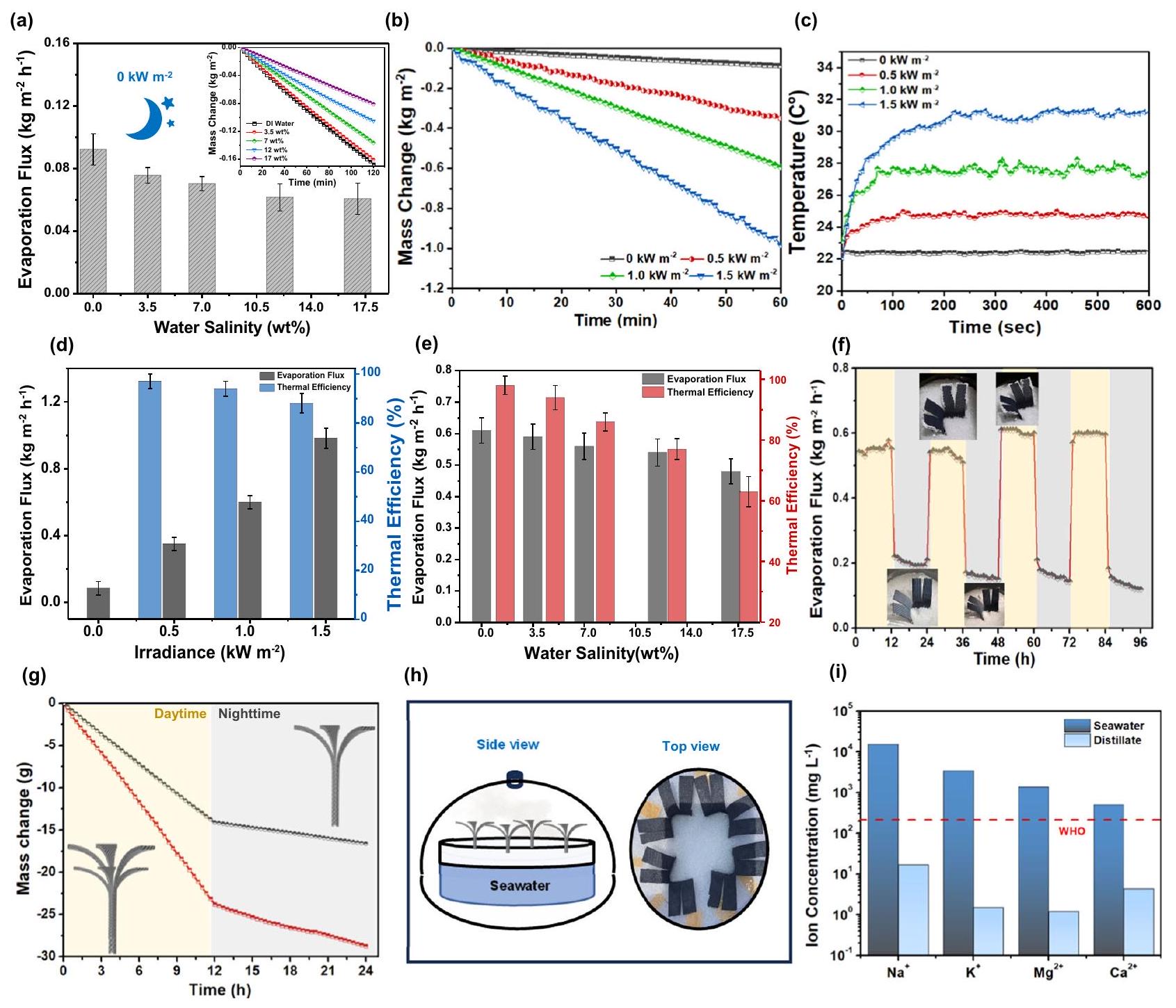
مستويات ملوحة مختلفة لتوليد بخار شمسي مستمر وجمع الملح (النتائج التفصيلية في الملاحظة التكميلية 4).
كان تدفق التبخر بناءً فقط على المنطقة العلوية المضيئة بالشمس 0.76 و 1.22 و
العملية الدورية لـ SVGC الشبيهة بالأشجار المانغروف
تم توضيحه من خلال التغير الخطي في كتلة الماء (الشكل 4أ). السبب في استقرار تدفق التبخر هو أن بلورات الملح كانت تنمو بشكل ملحوظ على حواف الأوراق بينما ظلت المنطقة المركزية نظيفة لامتصاص الضوء. ومع ذلك، عند استخدام محاليل عالية التركيز بملوحة
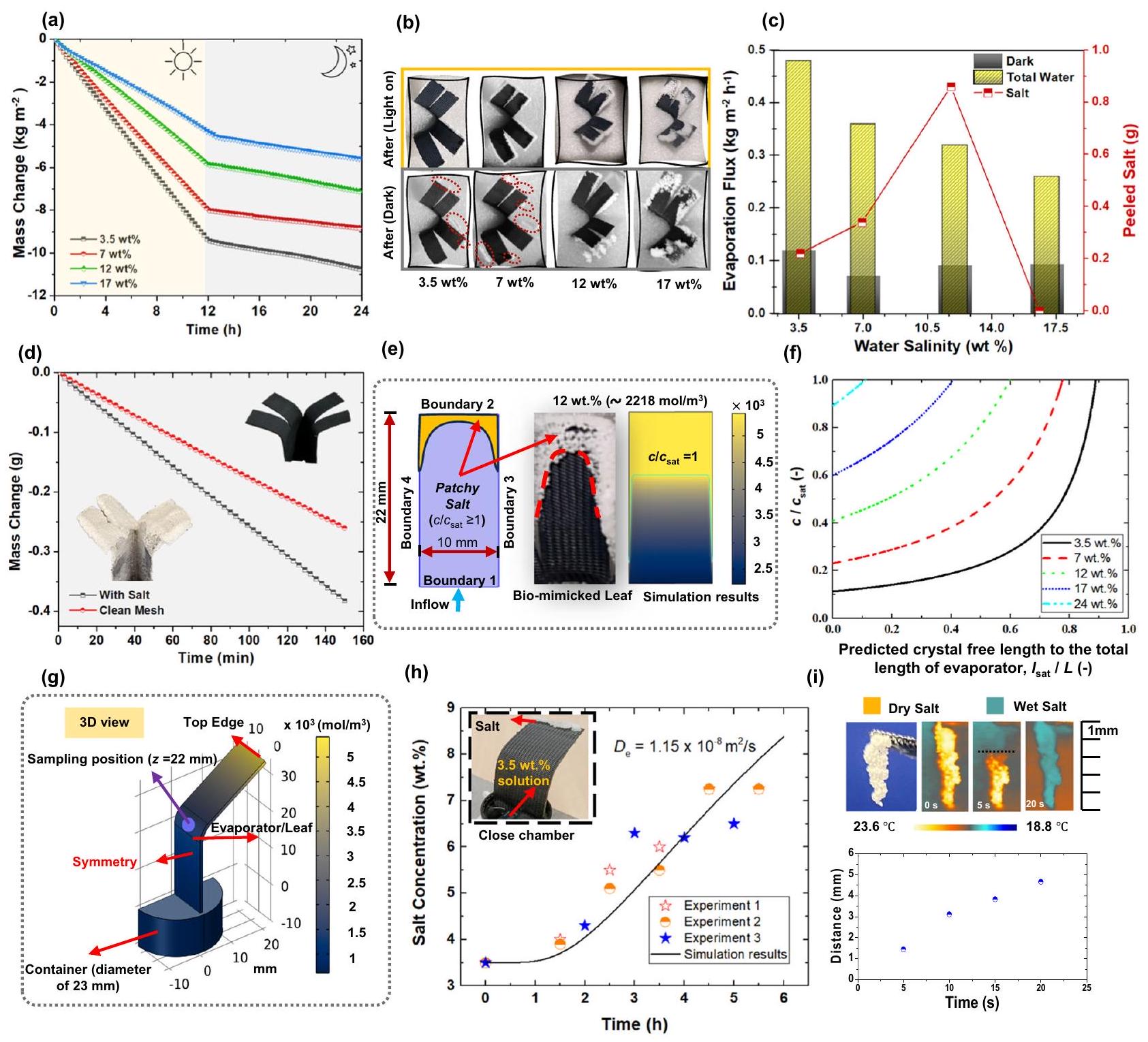
يوضح ملف الشكل الحجمي بعد 6 ساعات من الانتشار العكسي، بينما تقدم الشكل 4h النتائج التجريبية والمحاكاة لتغير تركيز الملح مع مرور الوقت عند
نقاش
كن أرق من ذلك عند السطح الرئيسي، وستؤدي التبخر الأعلى في منطقة الفيلم الرقيق إلى وصول المياه المالحة إلى حالة التشبع الفائق.
طرق
معالجة المواد وتوصيفها
تصنيع نموذج مختبري يشبه المانغروف مثل SVGC
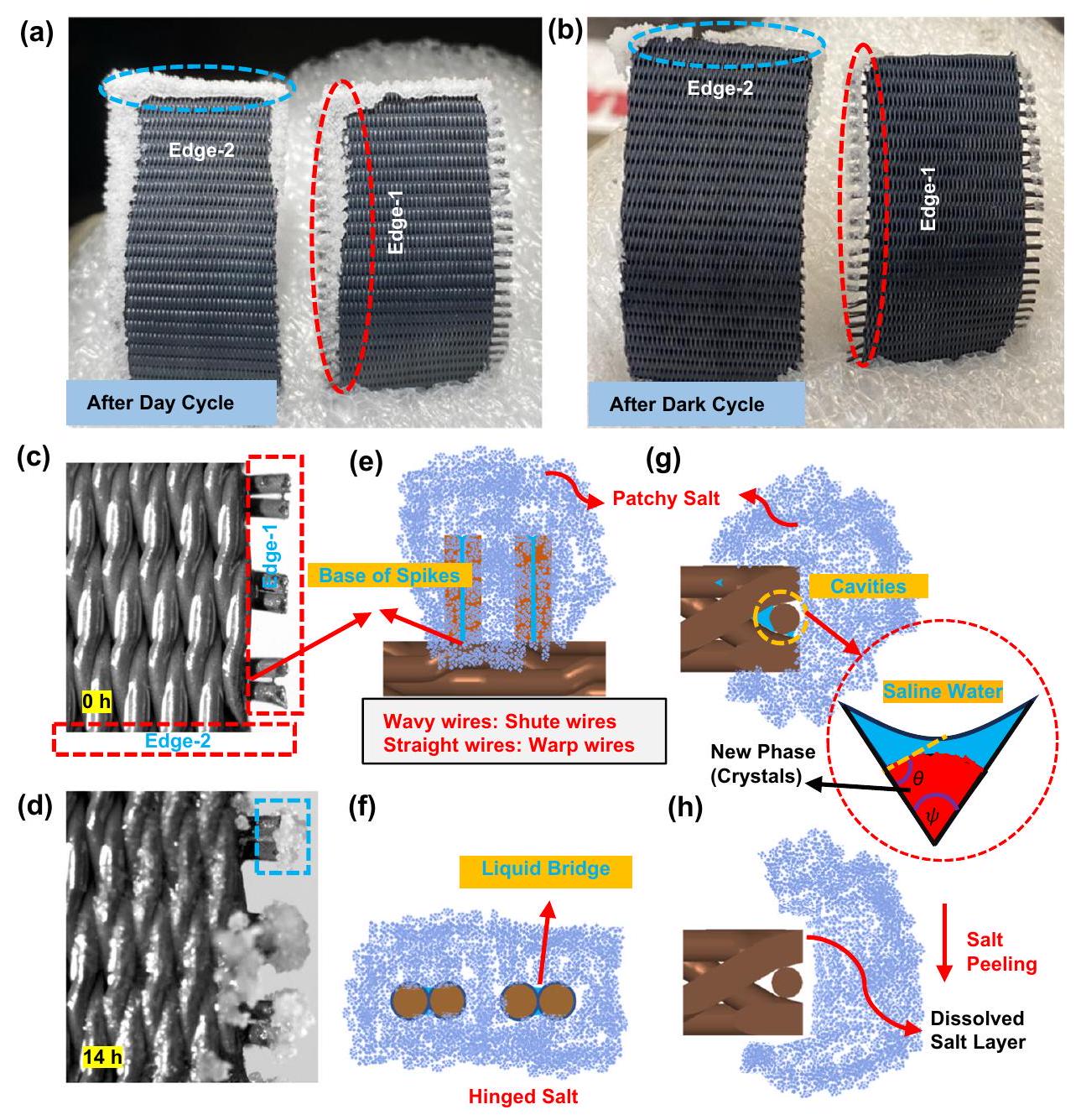
أسلاك من (e) عرض علوي و(f) عرض جانبي. مخطط لنمو وتقشير الملح عند حافة الورقة/الشبكة غير المدببة من (g) عرض علوي و(h) عرض جانبي. كما يوضح (g) نواة المرحلة الجديدة (أي بلورات الملح) داخل التجويف المخروطي المملوء بالماء المالح. أبعاد الأسلاك المنحنية الممتدة وأسلاك الشوت مبالغ فيها من أجل الوضوح في المخطط المقدم في (e-h).
توفر البيانات
References
- Vorosmarty, C. J., Green, P., Salisbury, J. & Lammers, R. B. Global water resources: vulnerability from climate change and population growth. Science 289, 284-288 (2000).
- Fayiah, M., Dong, S., Singh, S. & Kwaku, E. A. A review of water-energy nexus trend, methods, challenges and future prospects. Int. J. Energ. Water Res. 4, 91-107 (2020).
- Assad, M. E. H., AlMallahi, M. N., Abdelsalam, M. A., AlShabi, M. & AlMallahi, W. N. Desalination technologies: overview. in 2022 Advances in Science and Engineering Technology International Conferences (ASET) 1-4 (IEEE), 2022.
- Boretti, A. & Rosa, L. Reassessing the projections of the world water development report. NPJ Clean Water 2, 15 (2019).
- Mohsen, M. S., Akash, B., Abdo, A. A. & Akash, O. Energy options for water desalination in UAE. Procedia Comput. Sci. 83, 894-901 (2016).
- Shaheen, A. et al. Photothermal air gap membrane distillation for the removal of heavy metal ions from wastewater. Chem. Eng. J. 431, 133909 (2022).
- Tao, P. et al. Solar-driven interfacial evaporation. Nat. Energy 3, 1031-1041 (2018).
- Ghasemi, H. et al. Solar steam generation by heat localization. Nat. Commun. 5, 4449 (2014).
- Alketbi, A. S. et al. Direct solar vapor generation with micro-3D printed hydrogel device. Eco.Mat. 4, e12157 (2022).
- Ni, G. et al. Steam generation under one sun enabled by a floating structure with thermal concentration. Nat. Energy 1, 16126 (2016).
- Wang, X., He, Y., Liu, X., Cheng, G. & Zhu, J. Solar steam generation through bio-inspired interface heating of broadband-absorbing plasmonic membranes. Appl. Energy 195, 414-425 (2017).
- Abdelsalam, M. A., Sajjad, M., Li, H., AlMarzooqi, F. & Zhang, T. Direct solar thermal distillation with flower-mimicked vapor generator for freshwater collection. in Proceeding of International Heat Transfer Conference 1710 (Begellhouse, 2023). https://doi.org/10. 1615/IHTC17.400-90.
- Abdelsalam, M. A. M., Obaid, W., Ahmad, F. F., Hamid, A. K. & Ghenai, C. Modeling and Simulation of a Solar Powered Golf Cart
14. Ramirez, C., Almulla, Y., Joyce, B., Huber-Lee, A. & Nerini, F. F. An assessment of strategies for sustainability priority challenges in Jordan using a water-energy-food Nexus approach. Discover Sustain. 3, 23 (2022).
15. Maftouh, A. et al. The application of water-energy nexus in the Middle East and North Africa (MENA) region: a structured review. Appl. Water Sci. 12, 83 (2022).
16. Xu, N. et al. Going beyond efficiency for solar evaporation. Nat. Water 1, 494-501 (2023).
17. Wu, L. et al. Highly efficient three-dimensional solar evaporator for high salinity desalination by localized crystallization. Nat. Commun. 11, 521 (2020).
18. Ma, X., Jia, X., Yao, G. & Wen, D. Umbrella evaporator for continuous solar vapor generation and salt harvesting from seawater. Cell Rep. Phys. Sci. 3, 100940 (2022).
19. Yu, Z. et al. Intensifying the co-production of vapor and salts by a one-way brine-flowing structure driven by solar irradiation or waste heat. Desalination 539, 115942 (2022).
20. Li, H. et al. Mixed temperature gradient evaporator for solar steam generation. Cell Rep. Phys. Sci. 3, 101014 (2022).
21. Raza, A., Alketbi, A. S., Devarapalli, R., Li, H. & Zhang, T. Refractory Ultrathin Nanocomposite Solar Absorber with Superior Spectral Selectivity and Thermal Stability. Adv. Opt. Mater. 8, (2020).
22. Du, Y. et al. Janus film evaporator with improved light-trapping and gradient interfacial hydrophilicity toward sustainable solar-driven desalination and purification. Sep. Purif. Technol. 322, 124312 (2023).
23. Wei, C. et al. Easily scaled-up and portable 3D polysulfone hollow fiber membrane tree for high-efficient solar-driven clean water production. Solar Energy Mater. Solar Cells 257, 112340 (2023).
24. Sun, S. et al. 3D-printed solar evaporator with seashell ornamentation-inspired structure for zero liquid discharge desalination. Water Res. 226, 119279 (2022).
25. Zhang, C. et al. Designing a next generation solar crystallizer for real seawater brine treatment with zero liquid discharge. Nat. Commun. 12, 998 (2021).
26. Ni, G. et al. A salt-rejecting floating solar still for low-cost desalination. Energy Environ. Sci. 11, 1510-1519 (2018).
27. Xu, K., Wang, C., Li, Z., Wu, S. & Wang, J. Salt Mitigation Strategies of Solar-Driven Interfacial Desalination. Adv. Funct. Mater. 31, 2007855 (2021).
28. Liu, H. et al. High-Performance Solar Steam Device with Layered Channels: Artificial Tree with a Reversed Design. Adv. Energy Mater. 8, 1701616 (2018).
29. Chen, Y. et al. Marangoni-driven biomimetic salt secretion evaporator. Desalination 548, 116287 (2023).
30. Zhu, M. et al. Tree-Inspired Design for High-Efficiency Water Extraction. Adv. Mater. 29, 1704107 (2017).
31. Xu, N. et al. Mushrooms as Efficient Solar Steam-Generation Devices. Adv. Mater. 29, 1606762 (2017).
32. Wang, Y., Lee, J., Werber, J. R. & Elimelech, M. Capillary-driven desalination in a synthetic mangrove. Sci. Adv. 6, eaax5253 (2023).
33. Kim, K., Kim, H., Lim, J. H. & Lee, S. J. Development of a Desalination Membrane Bioinspired by Mangrove Roots for Spontaneous Filtration of Sodium Ions. ACS Nano. 10, 11428-11433 (2016).
34. Liu, H. et al. Sunlight-Sensitive Anti-Fouling Nanostructured TiO2 coated Cu Meshes for Ultrafast Oily Water Treatment. Sci. Rep. 6, 25414 (2016).
35. Li, H. et al. Biomimetic on-chip filtration enabled by direct micro-3D printing on membrane. Sci. Rep. 12, 8178 (2022).
36. Sajjad, M., Li, H., Raza, A., AlMarzooqi, F. & Zhang, T. Insights into capillary-driven motion of micro-particles interacting with advancing meniscus on a substrate. Soft Matter 18, 8894-8905 (2022).
37. Alhosani, M. H. et al. Enhanced Liquid Propagation and Wicking Along Nanostructured Porous Surfaces. Adv. Eng. Mater. 23, 2100118 (2021).
38. Al-Shammiri, M. Evaporation rate as a function of water salinity. Desalination 150, 189-203 (2002).
39. Zhou, L. et al. 3D self-assembly of aluminium nanoparticles for plasmon-enhanced solar desalination. Nat. Photonics 10, 393-398 (2016).
40. Xia, Y. et al. Spatially isolating salt crystallisation from water evaporation for continuous solar steam generation and salt harvesting. Energy Environ. Sci. 12, 1840-1847 (2019).
41. Shang, M. et al. Full-Spectrum Solar-to-Heat Conversion Membrane with Interfacial Plasmonic Heating Ability for HighEfficiency Desalination of Seawater. ACS Appl. Energy Mater. 1, 56-61 (2018).
42. Song, X. et al. Omnidirectional and effective salt-rejecting absorber with rationally designed nanoarchitecture for efficient and durable solar vapour generation. J. Mater. Chem. A Mater. 6, 22976-22986 (2018).
43. Nayar, K. G., Sharqawy, M. H., Banchik, L. D. & Lienhard, V. J. H. Thermophysical properties of seawater: A review and new correlations that include pressure dependence. Desalination 390, 1-24 (2016).
44. WHO Guidelines for Drinking-water Quality Policies and Procedures used in updating the WHO Guidelines for Drinking-water Quality Public Health and the Environment Water, Sanitation, Hygiene and Health.
45. Oman Humanitarian Desalination Challenge (OHDC). https:// desalinationchallenge.com/.
46. Aili, A., Ge, Q. & Zhang, T. How Nanostructures Affect Water Droplet Nucleation on Superhydrophobic Surfaces. J. Heat Transfer. 139, (2017).
47. Lewis, A., Seckler, M., Kramer, H. & van Rosmalen, G. Industrial Crystallization. (Cambridge University Press, 2015). https://doi.org/ 10.1017/CBO9781107280427.
شكر وتقدير
مساهمات المؤلفين
المصالح المتنافسة
معلومات إضافية
المواد التكميلية متاحة على
https://doi.org/10.1038/s41467-024-45108-2.
http://www.nature.com/reprints
© المؤلفون 2024
قسم الهندسة الميكانيكية والنووية، جامعة خليفة للعلوم والتكنولوجيا، صندوق بريد 127788 أبوظبي، الإمارات العربية المتحدة.
قسم الهندسة الكيميائية والنفطية، جامعة خليفة للعلوم والتكنولوجيا، صندوق بريد 127788 أبوظبي، الإمارات العربية المتحدة. ساهم هؤلاء المؤلفون بالتساوي: محمد أ. عبد السلام، محمد سجاد. البريد الإلكتروني: tiejun.zhang@ku.ac.ae
DOI: https://doi.org/10.1038/s41467-024-45108-2
PMID: https://pubmed.ncbi.nlm.nih.gov/38286989
Publication Date: 2024-01-29
Sustainable biomimetic solar distillation with edge crystallization for passive salt collection and zero brine discharge
Accepted: 15 January 2024
Published online: 29 January 2024
(A) Check for updates
Abstract
The urgency of addressing water scarcity and exponential population rise has necessitated the use of sustainable desalination for clean water production, while conventional thermal desalination processes consume fossil fuel with brine rejection. As a promising solution to sustainable solar thermal distillation, we report a scalable mangrove-mimicked device for direct solar vapor generation and passive salt collection without brine discharge. Capillaritydriven salty water supply and continuous vapor generation are ensured by anti-corrosion porous wicking stem and multi-layer leaves, which are made of low-cost superhydrophilic nanostructured titanium meshes. Precipitated salt at the leaf edge forms porous patch during daytime evaporation and get peeled by gravity during night when saline water rewets the leaves, and these salt patches can enhance vaporization by 1.6 times as indicated by our findings. The proposed solar vapor generator achieves a stable photothermal efficiency around 94% under one sun when treating synthetic seawater with a salinity of
substantial carbon footprint
makes it an excellent solar absorber with superhydrophilicity and anticorrosive properties. The evaporation and salt crystallization performance of the synthetic
Results
Conceptual design of SVGC

which is made of nano/micro-structured titanium (
a function of stem height (Fig. 1g). Our results have shown that the water supply rate is lower in the shute wires when compared to the warp wires. The pumping capacity is found to be significantly affected by the height of the stem, and it decreases as the stem height increases.
Design optimization and performance analysis of SVGC


different salinities for continuous solar vapor generation and salt collection (detailed results in Supplementary Note 4).
evaporation flux based only on the top solar illuminated area was 0.76 , 1.22 , and
Periodic operation of mangrove-like SVGC
demonstrated by the linear water mass change (Fig. 4a). The reason for stable evaporation flux is that salt crystals were noticeably growing on the edges of the leaves while the central area remained clean for light absorption. However, while using high-concentration solutions with a salinity of

illustrates the volumetric contour profile after 6 h of back diffusion, while Fig. 4 h gives experimental and simulation results for the variation in salt concentration over time at
Discussion
be thinner than that at the main surface, and higher evaporation at thin film region will lead saline water to reach supersaturation (
Methods
Material processing and characterization
Fabrication of lab-scale mangrove like SVGC

wires from (e) top and (f) side views. Schematic for the growth and peeling of salt at non-spike edge of the leaf/mesh from (g) top and (h) side views. g Also illustrates the nucleation of new phase (i.e., salt crystals) inside the cone-shaped cavity filled with saline water. The dimensions of the extended warp wires and shute wires are exaggerated for clarity in the schematic given in (e-h).
Data availability
References
- Vorosmarty, C. J., Green, P., Salisbury, J. & Lammers, R. B. Global water resources: vulnerability from climate change and population growth. Science 289, 284-288 (2000).
- Fayiah, M., Dong, S., Singh, S. & Kwaku, E. A. A review of water-energy nexus trend, methods, challenges and future prospects. Int. J. Energ. Water Res. 4, 91-107 (2020).
- Assad, M. E. H., AlMallahi, M. N., Abdelsalam, M. A., AlShabi, M. & AlMallahi, W. N. Desalination technologies: overview. in 2022 Advances in Science and Engineering Technology International Conferences (ASET) 1-4 (IEEE), 2022.
- Boretti, A. & Rosa, L. Reassessing the projections of the world water development report. NPJ Clean Water 2, 15 (2019).
- Mohsen, M. S., Akash, B., Abdo, A. A. & Akash, O. Energy options for water desalination in UAE. Procedia Comput. Sci. 83, 894-901 (2016).
- Shaheen, A. et al. Photothermal air gap membrane distillation for the removal of heavy metal ions from wastewater. Chem. Eng. J. 431, 133909 (2022).
- Tao, P. et al. Solar-driven interfacial evaporation. Nat. Energy 3, 1031-1041 (2018).
- Ghasemi, H. et al. Solar steam generation by heat localization. Nat. Commun. 5, 4449 (2014).
- Alketbi, A. S. et al. Direct solar vapor generation with micro-3D printed hydrogel device. Eco.Mat. 4, e12157 (2022).
- Ni, G. et al. Steam generation under one sun enabled by a floating structure with thermal concentration. Nat. Energy 1, 16126 (2016).
- Wang, X., He, Y., Liu, X., Cheng, G. & Zhu, J. Solar steam generation through bio-inspired interface heating of broadband-absorbing plasmonic membranes. Appl. Energy 195, 414-425 (2017).
- Abdelsalam, M. A., Sajjad, M., Li, H., AlMarzooqi, F. & Zhang, T. Direct solar thermal distillation with flower-mimicked vapor generator for freshwater collection. in Proceeding of International Heat Transfer Conference 1710 (Begellhouse, 2023). https://doi.org/10. 1615/IHTC17.400-90.
- Abdelsalam, M. A. M., Obaid, W., Ahmad, F. F., Hamid, A. K. & Ghenai, C. Modeling and Simulation of a Solar Powered Golf Cart
14. Ramirez, C., Almulla, Y., Joyce, B., Huber-Lee, A. & Nerini, F. F. An assessment of strategies for sustainability priority challenges in Jordan using a water-energy-food Nexus approach. Discover Sustain. 3, 23 (2022).
15. Maftouh, A. et al. The application of water-energy nexus in the Middle East and North Africa (MENA) region: a structured review. Appl. Water Sci. 12, 83 (2022).
16. Xu, N. et al. Going beyond efficiency for solar evaporation. Nat. Water 1, 494-501 (2023).
17. Wu, L. et al. Highly efficient three-dimensional solar evaporator for high salinity desalination by localized crystallization. Nat. Commun. 11, 521 (2020).
18. Ma, X., Jia, X., Yao, G. & Wen, D. Umbrella evaporator for continuous solar vapor generation and salt harvesting from seawater. Cell Rep. Phys. Sci. 3, 100940 (2022).
19. Yu, Z. et al. Intensifying the co-production of vapor and salts by a one-way brine-flowing structure driven by solar irradiation or waste heat. Desalination 539, 115942 (2022).
20. Li, H. et al. Mixed temperature gradient evaporator for solar steam generation. Cell Rep. Phys. Sci. 3, 101014 (2022).
21. Raza, A., Alketbi, A. S., Devarapalli, R., Li, H. & Zhang, T. Refractory Ultrathin Nanocomposite Solar Absorber with Superior Spectral Selectivity and Thermal Stability. Adv. Opt. Mater. 8, (2020).
22. Du, Y. et al. Janus film evaporator with improved light-trapping and gradient interfacial hydrophilicity toward sustainable solar-driven desalination and purification. Sep. Purif. Technol. 322, 124312 (2023).
23. Wei, C. et al. Easily scaled-up and portable 3D polysulfone hollow fiber membrane tree for high-efficient solar-driven clean water production. Solar Energy Mater. Solar Cells 257, 112340 (2023).
24. Sun, S. et al. 3D-printed solar evaporator with seashell ornamentation-inspired structure for zero liquid discharge desalination. Water Res. 226, 119279 (2022).
25. Zhang, C. et al. Designing a next generation solar crystallizer for real seawater brine treatment with zero liquid discharge. Nat. Commun. 12, 998 (2021).
26. Ni, G. et al. A salt-rejecting floating solar still for low-cost desalination. Energy Environ. Sci. 11, 1510-1519 (2018).
27. Xu, K., Wang, C., Li, Z., Wu, S. & Wang, J. Salt Mitigation Strategies of Solar-Driven Interfacial Desalination. Adv. Funct. Mater. 31, 2007855 (2021).
28. Liu, H. et al. High-Performance Solar Steam Device with Layered Channels: Artificial Tree with a Reversed Design. Adv. Energy Mater. 8, 1701616 (2018).
29. Chen, Y. et al. Marangoni-driven biomimetic salt secretion evaporator. Desalination 548, 116287 (2023).
30. Zhu, M. et al. Tree-Inspired Design for High-Efficiency Water Extraction. Adv. Mater. 29, 1704107 (2017).
31. Xu, N. et al. Mushrooms as Efficient Solar Steam-Generation Devices. Adv. Mater. 29, 1606762 (2017).
32. Wang, Y., Lee, J., Werber, J. R. & Elimelech, M. Capillary-driven desalination in a synthetic mangrove. Sci. Adv. 6, eaax5253 (2023).
33. Kim, K., Kim, H., Lim, J. H. & Lee, S. J. Development of a Desalination Membrane Bioinspired by Mangrove Roots for Spontaneous Filtration of Sodium Ions. ACS Nano. 10, 11428-11433 (2016).
34. Liu, H. et al. Sunlight-Sensitive Anti-Fouling Nanostructured TiO2 coated Cu Meshes for Ultrafast Oily Water Treatment. Sci. Rep. 6, 25414 (2016).
35. Li, H. et al. Biomimetic on-chip filtration enabled by direct micro-3D printing on membrane. Sci. Rep. 12, 8178 (2022).
36. Sajjad, M., Li, H., Raza, A., AlMarzooqi, F. & Zhang, T. Insights into capillary-driven motion of micro-particles interacting with advancing meniscus on a substrate. Soft Matter 18, 8894-8905 (2022).
37. Alhosani, M. H. et al. Enhanced Liquid Propagation and Wicking Along Nanostructured Porous Surfaces. Adv. Eng. Mater. 23, 2100118 (2021).
38. Al-Shammiri, M. Evaporation rate as a function of water salinity. Desalination 150, 189-203 (2002).
39. Zhou, L. et al. 3D self-assembly of aluminium nanoparticles for plasmon-enhanced solar desalination. Nat. Photonics 10, 393-398 (2016).
40. Xia, Y. et al. Spatially isolating salt crystallisation from water evaporation for continuous solar steam generation and salt harvesting. Energy Environ. Sci. 12, 1840-1847 (2019).
41. Shang, M. et al. Full-Spectrum Solar-to-Heat Conversion Membrane with Interfacial Plasmonic Heating Ability for HighEfficiency Desalination of Seawater. ACS Appl. Energy Mater. 1, 56-61 (2018).
42. Song, X. et al. Omnidirectional and effective salt-rejecting absorber with rationally designed nanoarchitecture for efficient and durable solar vapour generation. J. Mater. Chem. A Mater. 6, 22976-22986 (2018).
43. Nayar, K. G., Sharqawy, M. H., Banchik, L. D. & Lienhard, V. J. H. Thermophysical properties of seawater: A review and new correlations that include pressure dependence. Desalination 390, 1-24 (2016).
44. WHO Guidelines for Drinking-water Quality Policies and Procedures used in updating the WHO Guidelines for Drinking-water Quality Public Health and the Environment Water, Sanitation, Hygiene and Health.
45. Oman Humanitarian Desalination Challenge (OHDC). https:// desalinationchallenge.com/.
46. Aili, A., Ge, Q. & Zhang, T. How Nanostructures Affect Water Droplet Nucleation on Superhydrophobic Surfaces. J. Heat Transfer. 139, (2017).
47. Lewis, A., Seckler, M., Kramer, H. & van Rosmalen, G. Industrial Crystallization. (Cambridge University Press, 2015). https://doi.org/ 10.1017/CBO9781107280427.
Acknowledgements
Author contributions
Competing interests
Additional information
supplementary material available at
https://doi.org/10.1038/s41467-024-45108-2.
http://www.nature.com/reprints
© The Author(s) 2024
Department of Mechanical and Nuclear Engineering, Khalifa University of Science and Technology, P.O. Box 127788 Abu Dhabi, United Arab Emirates.
Department of Chemical and Petroleum Engineering, Khalifa University of Science and Technology, P.O. Box 127788 Abu Dhabi, United Arab Emirates. These authors contributed equally: Mohamed A. Abdelsalam, Muhammad Sajjad. e-mail: tiejun.zhang@ku.ac.ae
